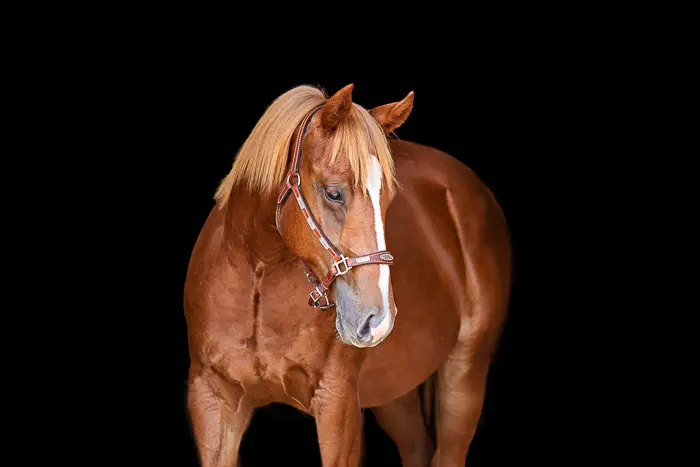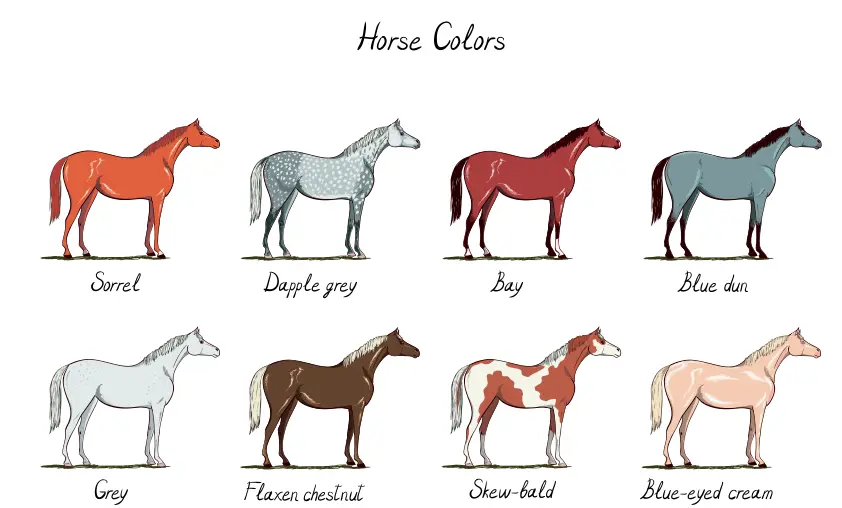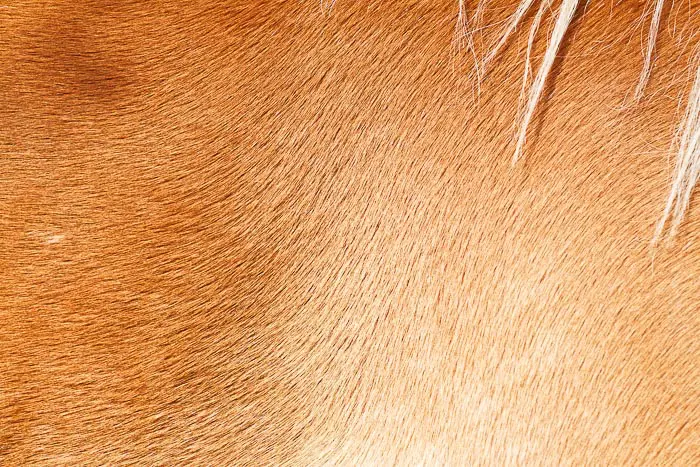What Color Is Sorrel on a Horse
A sorrel horse is one of many different colors of horse. Horses and ponies come in all different shapes, sizes, and colors, and it can get confusing at times.
Dr. Jess breaks down what sorrel horses actual are below:

All About Horses:
Horses and ponies, also known as 'equines', are one of the most popular of hooved pets.
Horses are herd animals, most preferring to be around other horsey-like friends versus being by themselves.
Horses and ponies come in all shapes, sizes, and colors, making so many different breeds popular for different reasons.
Horses are four-legged mammals with hooves, with a mane of hair running along the top of their neck, and a long tail on their rear.
Horses and ponies are herbivores, eating plants, and have the dentition (teeth structure) to show for it, large, flat-surfaced teeth, perfect for tearing and grinding vegetation.
Many horses and ponies today are pets and many of these pets are used for sport.
Some of the equestrian sports include hunting and jumping, dressage, reining, roping, cutting, endurance, vaulting, and eventing, to name a few.
Different Horse Colors:
Horses come in so many beautiful colors and shades.
Certain breeds, such as Haflingers, are more commonly seen with certain colors or shades or markings, and other breeds, like the American Quarter Horse, are seen in many different color varieties.
Some of the most common horse coat colors include greys, browns and bays, black and white, sorrel and chestnut, etc.
Other colors include duns, roans, and diluted colors such as palominos and cremelos.

Horse Markings:
On top of this large array of horse coat colors, many horses have a wide variety of markings to create unique variations in physical appearance.
Horse coat markings will help identify individual horses and is even necessary to note in certain veterinary forms and breed associations.
Common horse markings on the face include stars, snips, blazes, and bald faces.
Leg markings that are commonly observed are seen from as high up on the leg as the knee, referred to as a "high sock" all the way down to just barely creeping up beyond the hoof, referred to as a "coronet" band.
What Determines a Horse's Color?
All horse colors are either the base colors – black, bay, or chestnut/sorrel – or are the result from some modified combination of these base colors.
So what determines a horse's coat color? Well, it's all in the genes.
There are three genes that are known to help determine the base color of a horse's coat.
Understanding these three genes will help us in understanding horse color genetics.
These three color coat genes are given the designation of A, B, and E genes.
Other genes exist that control the modification or absence of color (ex. palomino) and/or patterning (ex. paint or pinto), are mentioned further down in this article.
So let's break this all down a bit more so that we can understand all of this coat color stuff…
Defining Horse Coat Color:
Defining horse coat color can be a pretty difficult task and there may be many differing opinions as to what color a horse is.
The first thing one must do is take a deep dive into what the skin color of the horse is.
Secondly, take a very close look at horse coat hairs – not just from one location on the horse's body – but look at horse hairs coming from the body, the face, the legs, etc.
Does the horse hairs have black pigment?
Does the horse have dark skin or rosy pink skin?
Look closely and observe in multiple locations throughout the horse's body!
Red Horse Coloring Genetics:
The gene that gives sorrels and chestnuts their red coloring is a recessive gene, also known as the 'red factor'. A recessive gene is a gene whose effects are not observed because of the presence of a more dominant gene, which will be the observed trait.
This means that a horse must have two red genes in order to be red.
This also means that two red horsey parents will have a red offspring every time.
The presence of any other color gene would mask the red (the recessive color), and the more dominant color would show through instead.
If a horse has black hair on their body, commonly found on many horses in their manes, tails, legs, and faces- then the animal has an allele of the E gene.
The E gene contains the blueprint for placing black pigment in the horse's hair.
Alternatively, the e allele allows black pigment in the skin but not in the hair, making the hair look red.
So, if a horse has the ee alleles, then the horse will have no black pigmented hair. In fact, an ee horse will have a shade of red coat color.
Sorrel Horse Color:
Sorrel horses have a reddish coat color and no black pigmentation involved.
It typically refers to a light, copper shade or red.
Sorrel horses are commonly treated as a very distinct color fromchestnut-colored horses, a browner shade of red.

Sorrel versus Chesnut Color:
Determining the correct term for a horse's color just based on appearance can start arguments between horse enthusiasts and can be surprisingly difficult to figure out.
This is especially true for sorrels versus chestnuts!
Horses that have that reddish or reddish-brown coat color appearance… chestnuts, sorrels, red or bay or chestnut roans. . . . what's the difference?
In terms of equine coat color genetics, which were discussed above, there is no difference between sorrels and chestnuts.
The red-brown coat color is a base color of many horses that is caused by that recessivee gene.
But different horsemen and equine enthusiasts may have a different opinion – that there IS a difference between a sorrel and a chestnut.
Many western horse lovers tend to consider red horses as sorrels, while many English riders consider this same red horse as a chestnut.
TheAmerican Quarter Horse Association uses both terms. They describe sorrel as a type of copper-red chestnut.
This usually is a subjective call.
The fact that horse coat color can vary by season, temperature, and environment, and can be affected by sun bleaching and grooming techniques such as body clipping, etc. should come into play when deciding on what coat color a horse is.
Other horse people say that if a red horse has a flaxen or lighter mane and tail, then it is a sorrel, and if it has darker mane and tail, then it is a chestnut. So many opinions!
For many horse lovers, they describe a sorrel horse as one that is a true red.
The horse lovers usually agree that a chestnut horse will often have a wine or brown-colored appearance, or look brownish-red, while a sorrel is clearly red.
This sorrel red can be any shade, whether it's pale or dark red.
Most horses considered sorrel, have the same color throughout their body, mane, and tail, with no or very little other white markings.
Some sorrels can have a flaxen or blonde mane and tail, but if there are black or dark markings on their bodies, then that horse would be considered chestnut.
Some breed organizations do not recognize the sorrel color, but may classify the color as chestnut.
The Jockey Club recognizes red and lighter brown thoroughbreds as chestnut, sorrel not even being an option in their registry.
The United States Trotting Association (Standardbreds) and the Arabian Horse Association does not recognize sorrel as a color either.
TheAmerican Quarter Horse Association uses both terms and describes their distinction between the two according to their standards.
Many other equine organizations simply avoid the issue altogether and choose either sorrel OR chestnut to denote all reddish or brown colors that do not fall under the category of 'bay'.
Summary:
Blondes are blonde, brunettes are brunette, and redheads are redheads, right?
No – not all redheads are the same!
There's such a wide variety of different types of equine coat colors that may look incredibly similar at first look, however, very different on closer inspection.
A sorrel horse is one that has a completely red base color and the opportunity of having white markings too.
While a sorrel and a chestnut horse are genetically the same combination of the E gene, many horsemen consider a sorrel horse a red horse with a red base and a chestnut horse, a much darker, brownish-red color.
With so many differing opinions, you will likely need to set your own parameters on what makes a horse a sorrel horse and what makes a horse a chestnut!
References Used in This Article:
- Red Factor
- "Introduction to Coat Color Genetics"from Veterinary Genetics Laboratory, School of Veterinary Medicine, University of California, Davis. Web Site accessed January 12, 2008
- UC Davis Veterinary Genetics Laboratory

What Color Is Sorrel on a Horse
Source: https://hashtaghorse.com/sorrel-horse/